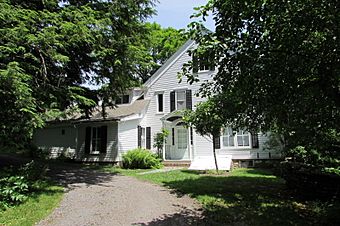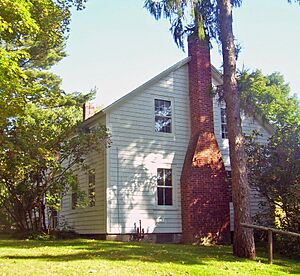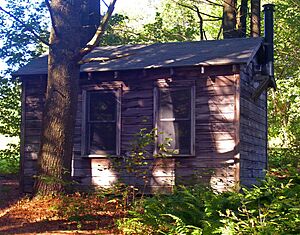Steepletop facts for kids
|
Edna St. Vincent Millay House & Gardens (Steepletop)
|
|

Front (south) elevation of main house, 2014
|
|
| Location | East Hill Road, Austerlitz, NY |
|---|---|
| Nearest city | Pittsfield, MA |
| Area | 500 acres (200 ha) |
| Built | c. 1870 |
| NRHP reference No. | 71000534 |
Quick facts for kids Significant dates |
|
| Added to NRHP | November 11, 1971 |
| Designated NHL | November 11, 1971 |
Steepletop is the historic farmhouse home of Pulitzer Prize-winning poet Edna St. Vincent Millay. She lived here with her husband, Eugen Jan Boissevain, in Austerlitz, New York, United States.
Today, the Edna St. Vincent Millay Society takes care of her former home and gardens. This group also manages the rights to her poems and writings. Steepletop was recognized as a National Historic Landmark on November 11, 1971. This means it's a very important historical place in the United States.
The Millay Colony for the Arts is located on land next to Steepletop. This colony was started by Norma Millay Ellis, Edna's sister. It became a separate non-profit organization in 1973.
The name "Steepletop" comes from a pink, cone-shaped wildflower called Steeplebush. This flower grows naturally in the area. The Millay Society started offering tours of the house in 2010.
Contents
Exploring the Steepletop Property
Steepletop is a large, 500-acre estate located in a hilly, wooded area. It's in the northeastern part of Austerlitz, close to the Massachusetts state line. The area is part of the Taconic Mountains but is also near the Berkshires, a region known for its music, arts, and outdoor activities.
Parts of the property are next to Beebe Hill and Harvey Mountain State Forest. You can reach the main buildings by taking East Hill Road from New York State Route 22.
Buildings on the Estate
East Hill Road goes through the Steepletop property. The most noticeable building is the guest house, which is now used as the Millay Society's offices. It's a two-story building with shingles on the outside and a pointed roof. It has two brick chimneys.
To the southeast of the guest house is a stable, which is now used as a garage. It has a studio on its second floor. A barn with a curved roof is located to the northeast.
Just north of the guest house, across the road, is the main house. This was Edna Millay's main home for many years. It's a two-story white house with a steep, pointed roof and a chimney in the middle. It's built into a hill that rises from the driveway. A smaller, one-and-a-half-story section extends from the north side.
The front of the house faces west and has a small, one-story porch over the main entrance. The entrance has side windows and a window above the door. The north section of the house has three windows that stick out from the roof.
Inside the Main House
When you enter the main house, you step into a long hallway with a stone floor. This hall is decorated with photos of Millay and art pieces she and her husband collected. These include a statue of Sappho and a special desk made for Millay.
Next to the hall is a living room with a wide brick fireplace. It has paintings by Norma Ellis, Edna's sister, and her husband Charles. At the east end of the hall is the dining room.
North of the dining room is the kitchen. It was updated in 1947 for a story in Ladies' Home Journal magazine. The kitchen has a pantry to its west. There's also a small room with a wood stove and a large storage room with a concrete floor, bathroom, and closet. This room holds recordings of Millay's poetry readings.
A staircase leads to the second floor. The library is on the south side, with shelves filled with Millay's books. Her bedroom is in the northeast corner. It still has the furniture she bought and the dresses she wore to poetry readings. A newer bedroom, used by her sister and brother-in-law, is to the west.
Other Features on the Grounds
Northwest of the main house is a small, one-story wooden cabin. Millay used this as her writing studio. It has a door at one end and windows on the sides. Inside, you can still see a stove, a long chair, a dresser, a desk, a chair, and a table with magazines from 1949, just as she left them.
Further from the house are two more buildings and Millay's grave. An old building used for storing ice is to the north. The Ellises later turned it into a workroom and storage space. West of the driveway is a swimming pool area. It has a covered patio that Millay called "the bar" and a lawn she called "the dingle."
Her grave is located off a dirt road that branches west from East Hill Road, about 1,000 feet north of the main house.
History of Steepletop
The guest house is thought to have been built in the late 1700s. The main house was built much later, around 1870. Edna Millay and her husband, Eugen Boissevain, bought the property in 1925. It was a 635-acre blueberry farm at the time.
They moved to Steepletop after Millay had already written some of her most famous poems. The quiet countryside allowed her to keep writing, and they lived there except for when they traveled.
Soon after moving in, the couple built the barn from a kit they bought from Sears. Millay also grew her own vegetables in a small garden near the icehouse. She had the writing cabin built for her work. They even had a tennis court.
After World War II, in the late 1940s, Millay left Steepletop less often. Her husband, Eugen, passed away in 1949. This made her even more private. She was found deceased at the bottom of the stairway in the main house in 1950. The fall was the cause of her death, but what led to it is not known.
Steepletop After Millay
After Edna Millay's passing, her sister Norma and Norma's husband, Charles Ellis, moved into the house. In 1973, they started the Millay Colony for the Arts on 7 acres around the guest house and barn. This colony provides a place for writers, visual artists, and composers to work.
After her husband passed away in 1976, Norma continued to manage the colony until her own passing in 1986. In 1980, she updated the barn to provide housing for visiting artists. In 1997, a new main building was built on the colony property, designed to be easy for everyone to use. The colony still offers one-month stays for artists from the U.S. and other countries.
In 2006, the state of New York bought 230 acres of Steepletop land for $1.69 million. This land was added to a nearby state forest preserve. The money from this sale helped the Edna St. Vincent Millay Society restore the farmhouse and its grounds. Their goal was to turn it into a museum.
The museum opened to the public in the summer of 2010. Guided tours of Steepletop and Millay's gardens were available from late May through mid-October. However, in November 2018, Steepletop closed to the public because of money challenges and the need for more restoration work.
Fundraising efforts are still happening, and the future of the museum house is being considered. Parts of the Steepletop grounds, including the Millay Poetry Trail that leads to her grave, are now open for special events.
The Edna St. Vincent Millay Society continues to manage the main house, the other buildings around it, and the entire property. They operate it as a historic house museum dedicated to Millay. They have worked hard to restore the house and grounds. In 2003, a group called the Friends of the Millay Society built the Millay Poetry Trail. This trail follows the dirt road to her grave and the graves of some family members. The trail is open to the public and has her nature poems posted along the shaded path.
See also





